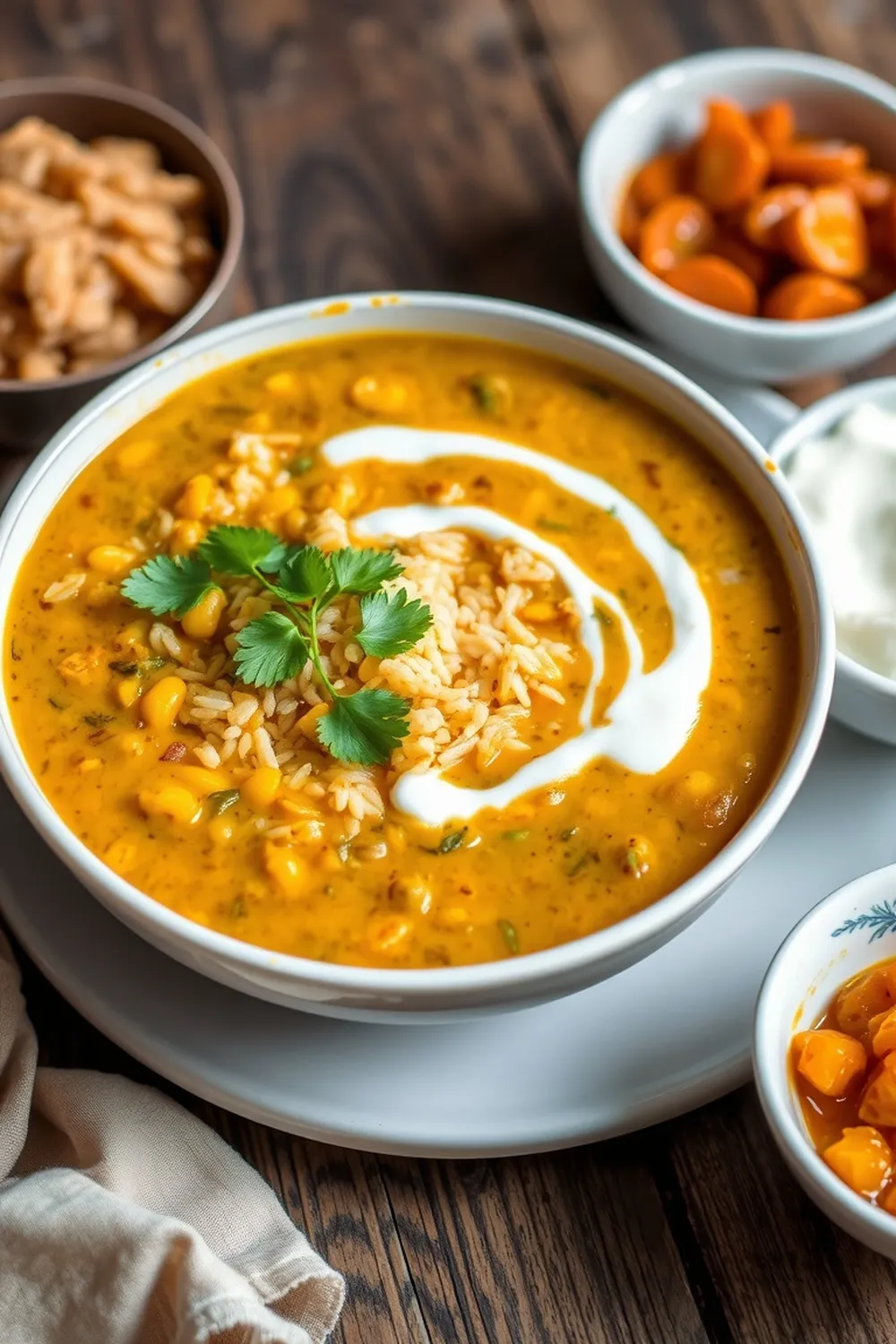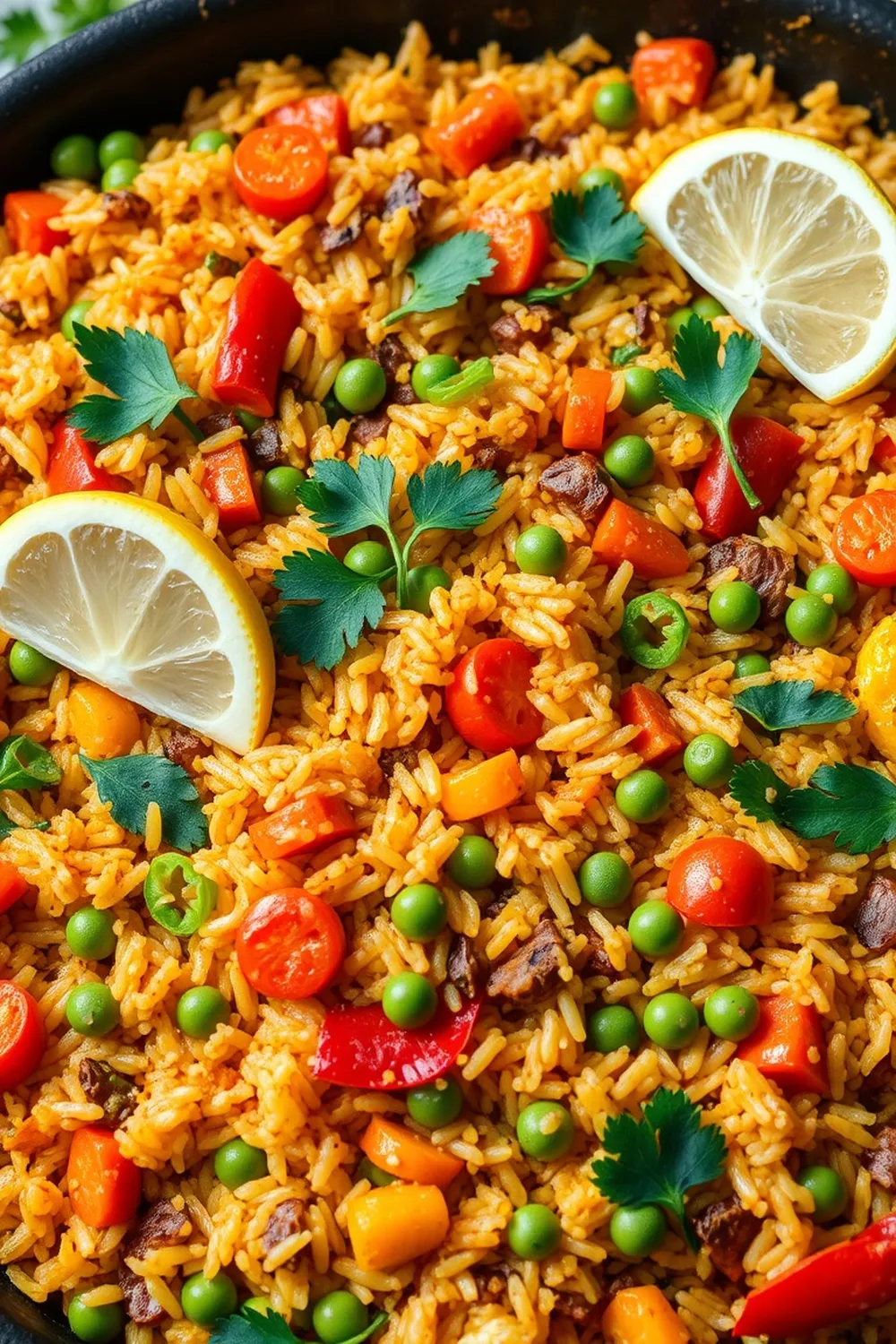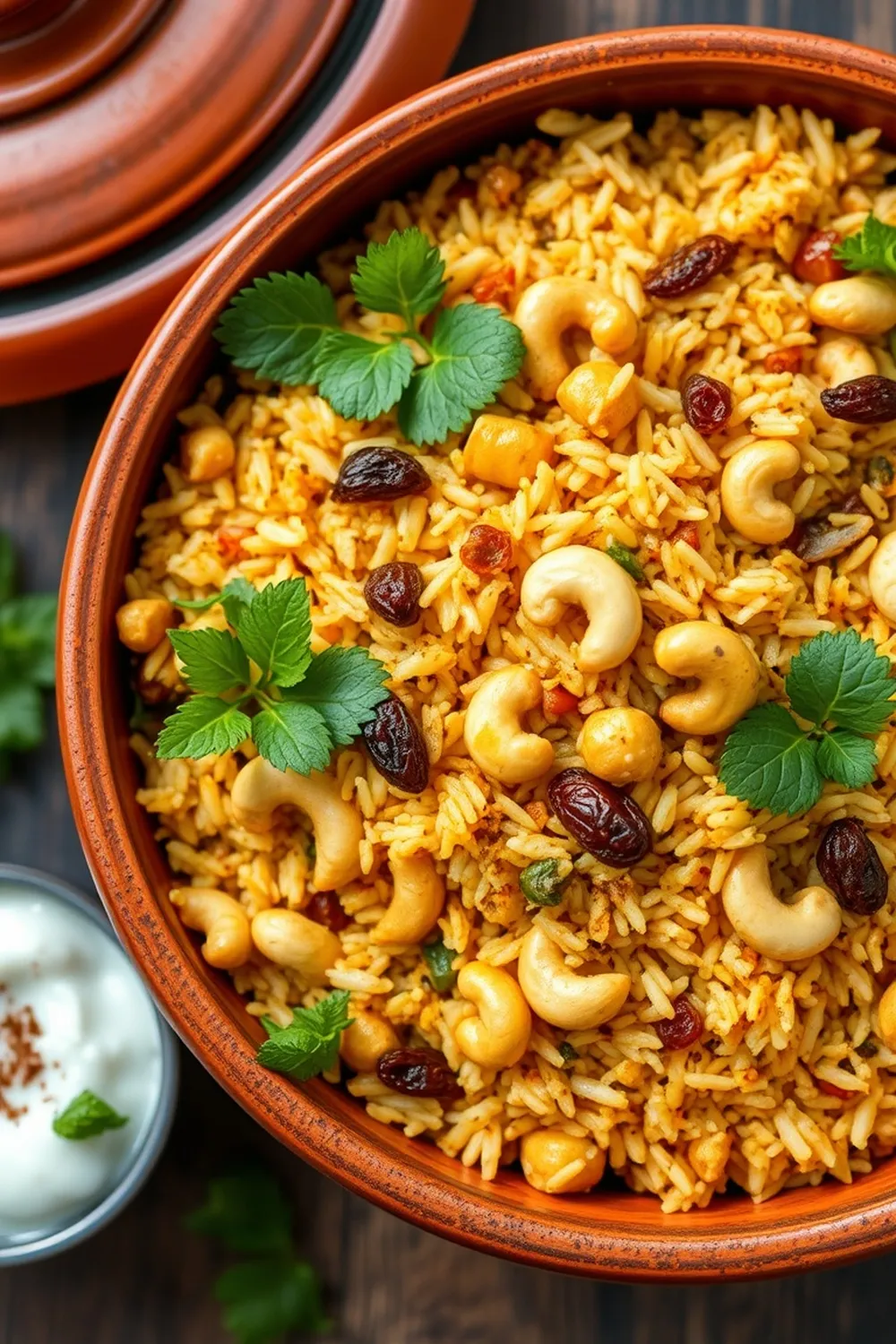- Rinse lentils and rice thoroughly. Soak for 20-30 minutes, then drain.
- In a pressure cooker, combine lentils, rice, water, green chilies, turmeric, salt, and a splash of ghee. Cook on low flame for 4-5 whistles. Let pressure release naturally.
- Heat ghee in a pan. Add cumin seeds and hing. Sauté until fragrant.
- Add ginger-garlic paste and cook for 1 minute. Stir in sliced onions and sauté until translucent.
- Mix in turmeric, chili powder, chopped tomatoes, and salt. Cook until tomatoes soften, adding water as needed.
- Combine cooked masala with the khichdi. Stir in kasuri methi and garnish with coriander leaves.
- Adjust consistency with hot water if needed. Serve hot with raita and pickle.
- Calories:300 kcal25%
- Energy:1255 kJ22%
- Protein:12 g28%
- Carbohydrates:45 mg40%
- Sugar:3 mg8%
- Salt:200 g25%
- Fat:8 g20%
Last Updated on 4 months by Neha Deshmukh
Authentic Khichdi Recipe – Lentils & Basmati Rice Comfort Food
Hey everyone! If you’re looking for a hug in a bowl, you’ve come to the right place. Khichdi (pronounced kich-ree) is the ultimate Indian comfort food. It’s simple, nourishing, and just… feels like home. I remember my grandmother making this for me whenever I was feeling under the weather, and honestly, it still works its magic today! This recipe is a classic, and I’m so excited to share it with you.
Why You’ll Love This Recipe
This khichdi is more than just a meal; it’s a feeling. It’s incredibly easy to make, perfect for a weeknight dinner, or when you just don’t feel like spending hours in the kitchen. It’s also wonderfully versatile – you can adjust the spices to your liking, and it’s naturally gluten-free! Plus, it’s packed with protein and fiber, keeping you full and satisfied. It’s a complete meal in one pot!
Ingredients
Here’s what you’ll need to create this comforting khichdi:
- 1 cup mixed lentils (Moong, Toor, and Masoor are a great combination)
- ½ cup basmati rice
- 4 cups water
- 2-3 green chillies, slit (adjust to your spice preference)
- ½ tsp turmeric powder
- Salt to taste
- 1 tbsp ghee (clarified butter)
- 1 tsp cumin seeds
- 1 pinch hing (asafoetida)
- 1 tsp ginger-garlic paste
- 1 onion, finely chopped
- ½ tsp turmeric powder (for the tempering)
- 1 tsp Kashmiri chilli powder (for colour and mild heat)
- 1 tomato, chopped
- 1 tbsp kasuri methi (dried fenugreek leaves)
- Coriander leaves, chopped (for garnish)
Ingredient Notes
Let’s talk ingredients! A few things make this khichdi extra special:
- Basmati Rice: Using basmati rice is key for that lovely fluffy texture. It’s also wonderfully fragrant! About 180g of basmati rice is equivalent to ½ cup.
- Lentil Blend: I love using a mix of lentils – it adds complexity to the flavour. Moong dal (split yellow lentils) is particularly easy to digest, making this dish gentle on the stomach.
- Ghee: Ghee adds a richness and flavour that’s just unmatched. It’s also considered very healthy in Ayurveda. You can use about 15ml of ghee for 1 tbsp.
- Hing (Asafoetida): Don’t skip the hing! It might smell a little funky on its own, but it adds a wonderful savoury depth to the khichdi and is known for its digestive properties. It’s a staple in Indian cooking, especially for lentil-based dishes, and helps reduce any gas. You can find it at most Indian grocery stores.
Step-By-Step Instructions
Alright, let’s get cooking!
- First, give the lentils and rice a really good rinse under cold water. This gets rid of any extra starch. Then, soak them in water for about 20-30 minutes. This helps them cook evenly. After soaking, drain the water completely.
- Now, into your pressure cooker (or a large pot if you don’t have one!), add the drained lentils and rice. Pour in the 4 cups of water, along with the green chillies, ½ tsp turmeric, salt, and a generous splash of ghee.
- Seal the pressure cooker and cook on low flame for 40-45 minutes. If you’re using a pot, bring to a boil, then reduce heat to low, cover, and simmer for about 45-60 minutes, or until the lentils and rice are soft and mushy. Remember to let the pressure release naturally – don’t force it!
- While the khichdi is cooking, let’s make the tadka (tempering). Heat the remaining ghee in a separate pan. Once hot, add the cumin seeds and hing. Let them sizzle for a few seconds until fragrant – be careful not to burn them!
- Add the ginger-garlic paste and cook for about a minute, until it loses its raw smell. Then, toss in the chopped onions and sauté until they turn translucent and golden brown.
- Now, add the ½ tsp turmeric powder, Kashmiri chilli powder, and chopped tomatoes. Cook until the tomatoes soften and break down, adding a little water if needed to prevent sticking.
- Once the pressure has released, carefully open the pressure cooker. The khichdi should be soft and creamy. Add the cooked masala (tempering) to the khichdi and stir well to combine.
- Finally, sprinkle in the kasuri methi and garnish with fresh coriander leaves. Give it a good stir, and that’s it!
Expert Tips
- Don’t be afraid to adjust the amount of water. You want a porridge-like consistency, so add more hot water if it’s too thick.
- For a smoother khichdi, you can lightly mash the lentils and rice with the back of a spoon.
- A little extra ghee never hurts!
Variations
- Vegan Khichdi: Simply substitute the ghee with any cooking oil, like vegetable or coconut oil.
- Gluten-Free: This recipe is naturally gluten-free! Just double-check that your spices are certified gluten-free if you have a severe allergy.
- Spice Level Adjustment: For a milder flavour, reduce or omit the green chillies and Kashmiri chilli powder. For a spicier kick, add a pinch of cayenne pepper.
- Monsoon/Rainy Day Adaptation: During the monsoon season, my mom always added a pinch of black pepper and a tiny piece of ginger to the khichdi. These warming spices are perfect for a chilly, rainy day.
Serving Suggestions
Khichdi is delicious on its own, but it’s even better with some accompaniments! I love serving it with a dollop of cool raita (yogurt dip) and a tangy pickle. A simple papadum (crispy lentil wafer) on the side adds a nice crunch.
Storage Instructions
Leftover khichdi can be stored in an airtight container in the refrigerator for up to 3 days. Reheat gently on the stovetop or in the microwave, adding a splash of water if needed.
FAQs
1. What type of lentils are best for Khichdi?
Moong dal (split yellow lentils) is the most commonly used and easiest to digest. But a mix of moong, toor (split pigeon peas), and masoor (red lentils) works beautifully too!
2. Can I make Khichdi in an Instant Pot?
Absolutely! Use the same ingredients and cooking time as the pressure cooker method, but reduce the water to 3 cups. Use the “Pressure Cook” setting on high for 15-20 minutes, followed by a natural pressure release.
3. How do I adjust the consistency of Khichdi?
If it’s too thick, add more hot water, a little at a time, until you reach your desired consistency. If it’s too thin, simmer uncovered for a few minutes to allow some of the liquid to evaporate.
4. What is Hing and where can I find it?
Hing, or asafoetida, is a resin with a pungent smell. It adds a unique savoury flavour to Indian dishes. You can find it at most Indian grocery stores, usually in powder form.
5. Can Khichdi be made ahead of time?
Yes! Khichdi actually tastes even better the next day. Just store it properly in the refrigerator and reheat when you’re ready to eat.
6. Is Khichdi a good option for babies or people with sensitive stomachs?
Yes, it is! Especially when made with moong dal, khichdi is very easy to digest and gentle on the stomach. It’s a popular first food for babies in India.
Enjoy this comforting bowl of goodness! I hope it brings you as much joy as it brings me. Let me know in the comments if you try it, and how it turns out!










